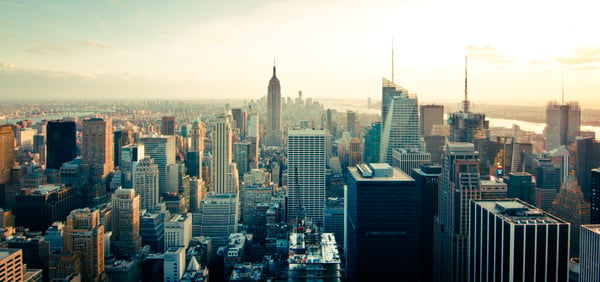Legislation announced Monday focuses on big buildings, and it could set a new standard for cities around the world.
This article was originally published by Alexander C. Kaufman for The Huffington Post.
A top New York City lawmaker announced a bill Monday to mandate dramatic energy use cuts in big buildings, by far the biggest source of carbon dioxide, in a historic move that could set a new standard for cities around the world
The legislation plans to require the city’s largest buildings to reduce energy use by 20 percent by 2030, as well as to set a framework for increasing the cuts by 40 percent to 60 percent by 2050. Combined with projected increases for renewable energy capacity on the power grid, the city could reduce its climate-warming emissions by 80 percent. Electricity and heating in buildings make up nearly 70 percent of the city’s climate pollution, with luxury towers producing the lion’s share.

“The low-hanging fruit is gone,” City Councilman Costa Constantinides, a Queens legislator who leads the council’s Committee on Environmental Protection, said Monday morning on the steps of City Hall. “If we are going to make a real impact on climate change, it’s going to be on buildings.”
The legislation, which is not yet complete, would make the nation’s largest and most economically influential metropolis among the first major cities in the world to mandate strict retrofits on existing buildings to reduce planet-warming emissions. The proposals outlined in the bill came from an unprecedented first agreement, released last week, between environmental groups, affordable housing advocates, unions and the city’s real estate lobby on a set of policies to slash buildings’ carbon pollution 80 percent by 2050.
The only thing similar to the proposal is a cap-and-trade policy in Tokyo that allows big commercial landlords in the Japanese capital to buy and sell a limited and shrinking number of CO2 pollution permits, said Russell Unger, executive director of the Urban Green Council. Besides that, the activists and industry representatives his group convened to negotiate the proposal only had the last set of New York laws to upgrade green building requirements to use as legal guidelines.
“Nobody has done this in the world,” Pete Sikora, a senior adviser at the grassroots nonprofit New York Communities for Change, said ahead of Monday’s press conference. “This is new stuff.”
Climate policies tend to ripple far beyond New York’s five boroughs. The city is a financial and cultural giant with a gross domestic product big enough to rank among the world’s top 20 economies.
In January, Mayor Bill de Blasio announced a city lawsuit against five major oil companies over infrastructure damage from climate change; New York became one of the biggest municipalities to mount such a legal challenge. The mayor also unveiled plans to divest roughly $5 billion in fossil fuel investments from the city’s five pension plans. Other cities quickly followed suit, and, in July, Rhode Island became the first state to sue big oil firms.
The agreement last week came after months of talks between environmental groups and the powerful Real Estate Board of New York, which spent a record $10 million through its super PAC in 2013 on typically sleepy citywide races. In the end, the industry agreed to a legally enforceable 2030 target in exchange for more flexibility on how to reach the 2050 goals.
“We don’t view it as a compromise,” Sikora said. “It’s a great deal. It’s a principled, bold, progressive approach.”
In a statement that left open the possibility that things could change as the bill is is written, REBNY said the proposal was a “ framework of principles” that show it recognizes “that climate change is a societal problem.”
“This means that every sector, including real estate, needs to help address it.” John H. Banks, REBNY’s president, said in the statement. “We appreciate Council Member Constantinides’ commitment to this issue and we look forward to reviewing the legislation once it is introduced.”
De Blasio has twice attempted to mandate emissions cuts from privately-owned buildings, first in 2016 and then again in 2017. But the plans went nowhere. REBNY vocally opposed the first plan. Then last September, the mayor released his second, more-detailed plan without coordinating with his usual environmental allies on the City Council, alienating legislators who were working on their own bills to cut emissions. They declined to back de Blasio’s proposal.
Constantinides introduced his own, more ambitious, bill in October.
But both mandates amounted to “half measures,” according to a report New York Communities for Change released in June. The mayor’s plan would lead to only 7 percent cuts in the city’s climate pollution. Constantinides’ bill, Intro 1745-2017, only reduced emissions by 13 percent.
There’s some concern the new legislation could put the onus to make cuts primarily on city-owned buildings. The Urban Green Council proposal calls for public-sector buildings larger than 10,000 square feet to slash energy use 20 percent by 2025, twice as fast as privately owned buildings. That’s a break from the mayor’s proposal in 2016, which called for a mandated fossil fuel cap to be applied to all buildings greater than 25,000 square feet, according to Politico New York. But “the vast majority of buildings affected by our policy framework are privately owned,” according to Unger.
The new bill already enjoys strong endorsements. Both the mayor and Council Speaker Corey Johnson signaled their support for the legislation on Monday.
The bill is also expected to give extra leeway to New York’s 1 million remaining rent-controlled apartments, to keep landlords from passing on the costs of retrofits to renters. Once Constantinides’ bill becomes law, Sikora said the next step would be pushing state lawmakers to pass similar requirements with protections for low-income renters.

Yet the new bill’s ambitious targets stirred some skepticism among climate scientists.
“I would expect, like all these agreements, the devil is in the details,” David Titley, a climate scientist at Pennsylvania State University and a retired Navy rear admiral, said, questioning whether a final law would contain sufficient penalties or “credible independent monitoring to ensure the standards are actually being met.”
The bill also aims to make cuts by mid-century that a growing number of climate activists say must be completed by 2035. Rep. Tulsi Gabbard (D-Hawaii) proposed the Off Fossil Fuels for a Better Future Act last September, calling for the end of oil, gas and coal use by 2035. Alexandria Ocasio-Cortez, the high-profile Democrat favored to be the next U.S. representative from New York’s 14th Congressional District, is running on a similar proposal.
“I’m glad to see it pass … but we need to advance our targets in alignment with the emergency nature of the crisis,” said Gregory Schwedock, an activist with the Climate Mobilization, a grassroots group calling for World War II-levels of government spending to dramatically scale down emissions and create good-paying federal jobs. “This will not cement politicians’ climate legacies or protect us ― emissions reductions wise, the targets are much too slow and it’s a small step.”
But Michael Mann, a climate scientist and author of The Madhouse Effect: How Climate Change Denial Is Threatening Our Planet, Destroying Our Politics and Driving Us Crazy, said the 2050 target is “reasonable because infrastructure takes a long time to change, given the investment timescales involved with real estate construction.”
For Rachel Rivera, whose roof caved in during Superstorm Sandy, the legislation offers hope for a path forward. At Monday’s press conference, she repeatedly broke down in tears as she recalled snatching her daughter out of bed just before the ceiling buckled with water and fell where the 6-year-old had just been. To this day, Marisol Rivera, now 12, suffers from severe post-traumatic stress disorder. She became so hysterical when it started raining on Saturday that Rachel Rivera took her to the hospital, where the girl was sedated.
“To this day, when it rains really hard outside, she says, ‘Mommy, are we going to live today? Are we going to pass away?’” Rivera said. “The climate crisis is here. We’re living it every day.”
This article was originally published by Alexander C. Kaufman for The Huffington Post.
